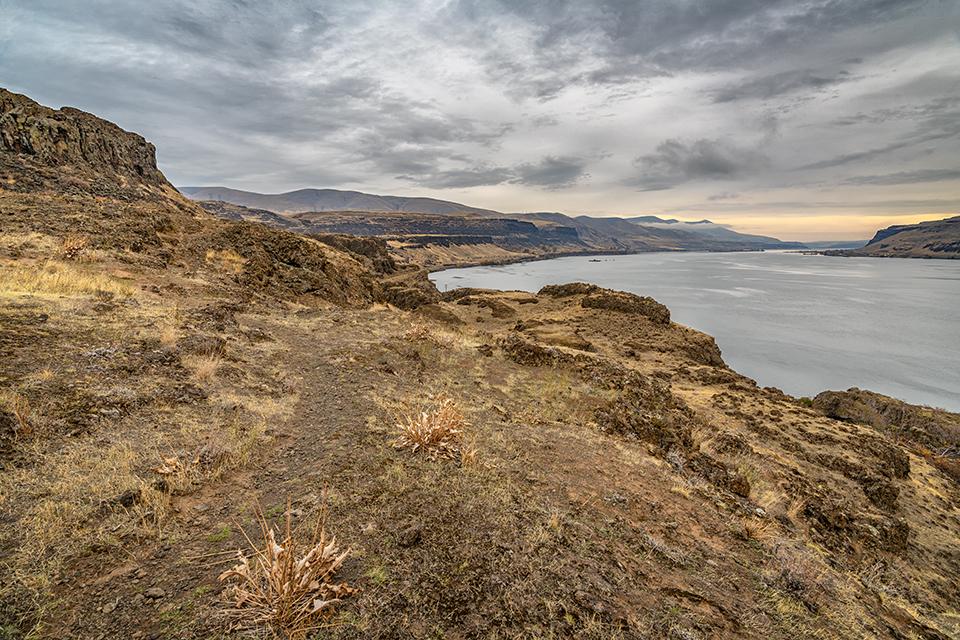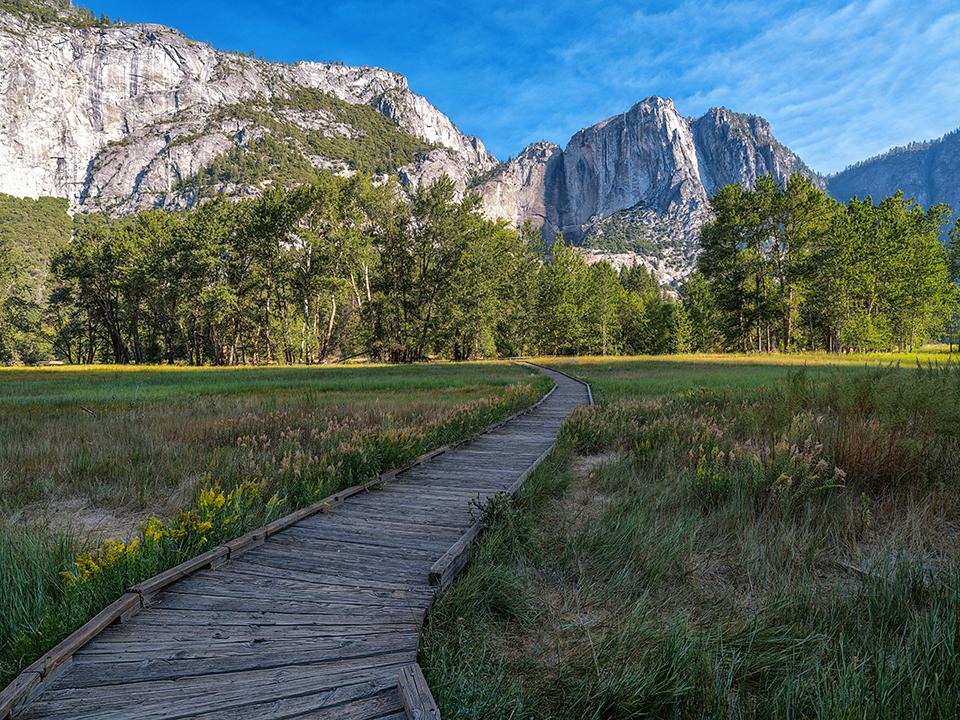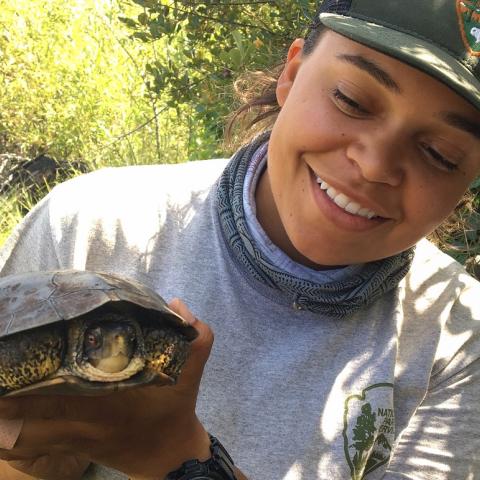
Sunrise along Wheeler Peak Scenic Road, Great Basin National Park / Rebecca Latson
Happy New Year! Did you travel to one or more units of the National Park System in 2021? Are you already planning your 2022 trip(s)?
I didn’t travel to any national parks during the first half of 2021, but the second half saw me making up for that with visits to Mount Rainier, Yosemite, and Great Basin national parks, in addition to a few sites along the Washington state portion of the Lewis and Clark National Historic Trail (you’ll read about that in the 2022 February, March, and April photo columns). From these park trips, I have favorite shots I’d like to share with you, in keeping a tradition I began with the Traveler about eight years ago. These 10 favorite shots are in no particular order. Each image is accompanied with a description of why I like it, what I was feeling at the time, and how I captured the shot.
Sunrise Along Wheeler Peak Scenic Road, Great Basin National Park (Nevada)
I am a sunrise kind of gal. I’m an early riser and sunrise, for me, represents new beginnings. Of all the sunrise shots I captured during my visit to this national park, the one pictured at the beginning of this column is my favorite. I like the way the colors create layers grading from shades of dark blue to brighter shades of golden yellow. I also like the silhouetted Nevada landscape. The hazy environment, due to wildfire smoke wafting in from neighboring California, created a certain diffuse atmosphere to the entire composition, reminiscent of those hazy mountain silhouettes you see in photos captured at Great Smoky Mountains National Park. As with most of my sunrise imagery, the camera was on a tripod to reduce camera shake. ISO was 160, to keep the image from becoming too grainy, which it would have been had I used a higher ISO – especially if I’d tried to handhold the camera for the shot. The shutter speed was much slower (hence the use of a tripod), at 0.3 seconds, but the kicker was that the aperture was very, very small, at f14. In retrospect, it was dark at the time, and while I normally know my camera knobs by feel, I think I might have accidentally moved the aperture dial instead of the shutter speed dial. The setup was not exactly as intended, but it worked, nonetheless, in capturing the essence of the scene prior to full arrival of the sun above the horizon. Oh, I also used my camera’s 2-second timer to reduce vibration caused by my finger pressing down on the shutter button. FYI, unless I am handholding my camera, all my shots using a tripod are done with that 2-second delay.
Hummingbird On Beeweed, Great Basin National Park (Nevada)

Hummingbird on beeweed, Great Basin National Park / Rebecca Latson
Hands down, hummers are my favorite birds. Not only are they adorable and create a joyful feeling for me, but they remind me of my mother. Mom loved watching all the little hummingbirds swarming her feeders during their September migration through southeast Texas. So, when I saw this little gal (I think – no colorful gorget to indicate a male) flitting around from flower to flower in the small garden beside the Great Basin Visitor Center outside of Baker, Nevada, I couldn’t help but think of Mom while I spent a good 20-30 minutes capturing this tiny bird’s food flights. I handheld my Sony a1, which has a high fps (frames per second) burst rate and used my 100-400mm telephoto lens. For birdlife and most wildlife, a camera that fires off fast shutter clicks is a great aid in getting at least one good sharp view of a moving subject. Most SLRs also have a focus setting for moving subjects, and point-and-shoot cameras may offer a similar setting. Another trick is to use a high ISO with a high shutter speed to counter the amount of light onto the camera’s sensor due to the high ISO. The higher the shutter speed, the better chance at freezing wildlife motion.
Rock And River, Lewis and Clark National Historic Trail (Washington)

Rock and River, Lewis and Clark National Historic Trail / Rebecca Latson
You’re probably looking at this and wondering why on earth it’s a favorite. It’s a bit on the dark side and a little muted and moody because of the overcast, rainy, autumn day. It’s for those very those reasons I have included it. In many of my past photo columns, I stressed how a good photo has the propensity to elicit emotion. Sometimes, it’s not so much about the details of the photo itself as it is about what the photographer was thinking or feeling at the time of the shutter click, and what it makes you think about or feel when you look at the photo. This image, captured near the trail terminus around Horsethief Butte, gives the viewer a clue as to the sweeping grandeur of the Columbia River rolling between golden hills littered with sharp-edged basalt rocks and columnar basalt ledges. I photographed this image in early November. It was autumn in the Pacific Northwest when Lewis and Clark and their band of 33 guides, hunters, and translators approached the Pacific coast via the Columbia River. No Gore-Tex or fleece for them. No paved highways or cushy cars with the heat running. No Sirius XM to while away the drive time. They were wet, cold, miserable, and in some cases, quite sick. Yet, this intrepid band soldiered on to the end of their journey. At times, they even remarked upon the beauty of a particular landscape. The least I could do, standing in my Gore-Tex and fleece, was to capture an image of a scene Lewis and Clark probably witnessed as well … on a stark, wet, overcast, autumn day in 1805.
The Start Of Sunrise Over Cape Disappointment, Lewis and Clark National Historic Trail (Washington)

The start of sunrise over Cape Disappointment, Lewis and Clark National Historic Trail / Rebecca Latson
I’d discovered Cape Disappointment and king tides via a Flickr search for images captured at Cape Disappointment State Park (did you know the Traveler has a Flickr Group Page?). One look at the beauty of the area and the crashing waves convinced me to further continue my exploration of this national historic trail in Washington state. I’d arrived early at the jetty on the park’s Waikiki Beach, not because I wanted to capture sunrise images, but because I didn’t know what to expect. Good thing I did arrive early, because the jetty was already lined with photographers. From my spot inserted between a couple of photographers’ cameras on tripods, I captured several shots of the beautiful green water, silhouetted rocks and lighthouse, and a promise of the rising sun (which actually had already risen above the horizon but was still hidden from view by the cliff).
I did not use a tripod for this image. For photographing moving subjects, from wildlife to ocean waves, I handhold my camera for ease of movement. To minimize blur from camera shake for this image, I switched on my camera’s shake reduction setting, used an aperture of f9, and bumped up the shutter speed to 1/500 of a second. Normally, that would make for an extremely dark image – so dark you couldn’t see anything in the composition except black. But I increased the ISO, which allowed the camera to pick up quite a bit of light, and in turn permitted me to use that 1/500 shutter speed to freeze the wave motion.
An Autumn Sunrise Over Paradise, Mount Rainier National Park (Washington)

An autumn sunrise over Paradise, Mount Rainier National Park / Rebecca Latson
The last time I captured autumn colors like this at the Paradise area was back in 2010. I had not thought to arrive early enough for sunrise shots back then, but this time, I arrived pre-sunrise, all set to capture the beautiful autumn light I knew would bathe the snowcapped mountain and colorful huckleberry bushes. You may notice that I’ve placed “The Mountain” smack dab in the middle of the shot. Usually, I don’t do that, but for this view, positioning the mountain in the middle of the frame allowed it to take center stage while wreathed in reds and purples from the huckleberry bushes, greens from the trees, and bright blue sky at the top.
A Frosty Sunrise Kiss On The Mountain, Mount Rainier National Park (Washington)

A frosty sunrise "kiss" on "The Mountain," Mount Rainier National Park / Rebecca Latson
I can’t tell you the number of times I’ve tried to achieve what I feel would be just the right shot of “The Mountain” at this location. This chilly, snowy, pre-sunrise autumn image made me feel like I’d finally captured the shot to my satisfaction. Most of the time, a sunrise photographed at this location – a long paved view area about a fourth mile below the Chinook Pass Summit (Hwy 410) – looks almost too saturated, as the sunlight progresses over Mount Rainier. It looks like I’ve overdone the colors when in truth, the colors are as saturated as they appear. So, with this composition, I aimed for a much colder, crisper feel to this “episodically active” volcano recumbent above beautiful alpine Tipsoo Lake. There’s a “kiss” of morning sunlight on the mountain, but the majority of the shot is sort of “monochrome-ish,” due to the earlier snowfall, offering up a cold blue cast to the entire composition.
A Saturated Hazy Sunrise At Tunnel View, Yosemite National Park (California)

A saturated hazy sunrise at Tunnel View, Yosemite National Park / Rebecca Latson
In all my years of photography, not to mention my years photographing for the Traveler, I’d yet to visit Yosemite National Park. Things worked out in 2021 for me to drive down there from my central Washington home (it’s a long drive, believe me). I wanted my very first view of Yosemite Valley to be during sunrise at Tunnel View, one of the most famous and oft-photographed spots within the park. After getting lost and ending up down in the valley during the pre-dawn hours, I finally made it back up to this view, thankfully, in time for sunrise. I set up tripod and camera with nobody else around me (which lasted for all of 10 minutes before people began to stream in). I already knew sunrise would not be a dramatic affair, having seen photos of other Tunnel View sunrises. It was muted and hazy due to area wildfire smoke, but it was also colorful and saturated. That color and saturation lasted for only a few minutes, and I was lucky enough to acquire the shot. It’s always good to arrive at a sunrise scene at least 30 minutes, if not more, prior to the event. Waiting until the last minute means you risk missing those valuable photographic moments prior to and a little after sunrise because you are too focused on staking out a place for your tripod and setting things up.
A Yosemite Summer Sunset, Yosemite National Park (California)

A Yosemite summer sunset, Yosemite National Park / Rebecca Latson
I spent the late afternoon hours (4-6 p.m.) in the Glacier Point and Washburn Point areas before deciding to pack it in and drive back to my Wawona cabin. As I drove down the road toward the intersection with Wawona Road, I looked over to my right to see a long view area with several people all watching the beginning of this incredible, vibrant sunset. I drove down a little further, realized how much I’d regret not capturing that scene, and turned around (no easy feat on that road) to return to that view area just in time to photograph this gorgeous sunset over the landscape around El Portal and beyond. A wide-angle composition was lovely but there was too much foreground of dark, mangled trees and snags. So, I zoomed in and used that one tree to frame the left of the composition, while placing the setting sun to the right, using the Rule-of-Thirds technique.
A Leading Line Boardwalk Over A Yosemite Valley Meadow, Yosemite National Park (California)

A leading line boardwalk over a Yosemite Valley meadow, Yosemite National Park / Rebecca Latson
I am a huge fan of the leading line technique, where the viewer’s eye is drawn from Point A to Point B in a composition. Naturally, I had to use the boardwalk across one of Yosemite Valley’s meadows as a leading line to move the eyes from the bottom of the shot up and toward the line of trees and sheer granite canyon walls. There was a fine balance to maintain between the shaded foreground and the sunny background. I exposed for the bright area to keep it from being “blown out” and lightened the darker area during the editing stage.
Glacial Erratics And Granite Joints At Olmsted Point, Yosemite National Park (California)

Glacial erratics and granite joints at Olmsted Point, Yosemite National Park / Rebecca Latson
I love geology, and Yosemite is full of it. You can especially see the effects of glacial wear and tear along Tioga Road through the rounded granite hills and mountains of the High Sierras. Olmsted Point is a must-see spot, with a view of Half Dome’s other side beyond the jointed granite and glacial erratics. I deliberately included that family of three in this image (up and right of center), because they provided great scale and perspective. The scene would be lovely without the people, but you might not realize the size of the erratics haphazardly scattered upon the cracked granite.
There you have it: my 10 favorite national park unit shots from 2021. I’m already planning photo trips for 2022 (barring any unforeseen issues) to share with you throughout the year. Hopefully, you are planning your own national park visits. Nowadays, it pays to start planning early. Right?




 Support Essential Coverage of Essential Places
Support Essential Coverage of Essential Places







Comments
Thank you for sharing such strikingly beautiful photos!!
Cape Dissapointment is a great picture...Thanks for sharing